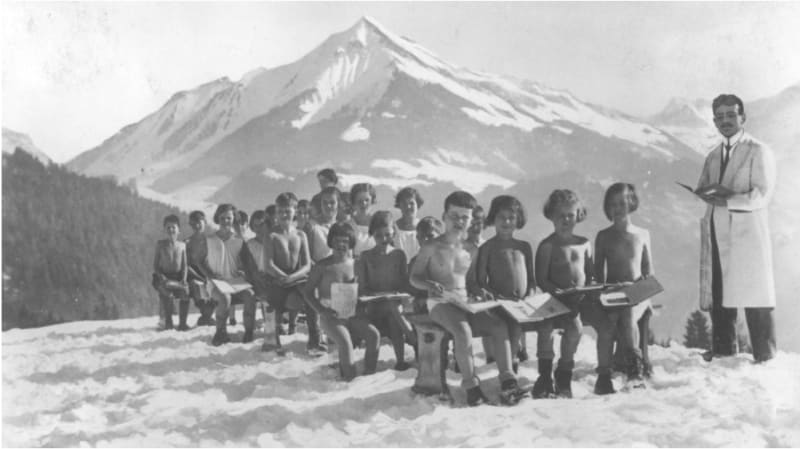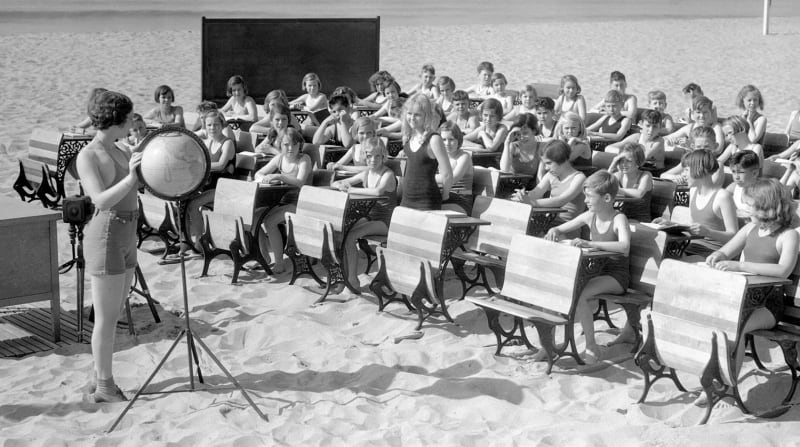Lessons in the snow, lessons on the beach

Norman Collier was a pupil at Aspen House School, Lambeth, in London in the 1930s. He remembers how, in the winter “… when we got there in the morning, the snow would have blown in on to the tables and chairs and we would have to clear it off before we could start.” The snow could get in because the classrooms were freestanding pavilions with large unglazed openings in place of windows. Aspen House was an ‘open-air school’: part of an international movement in education in the first half of the 20th century.
The very first such school was built in woods at Charlottenburg near Berlin in 1904. It was the creation of a paediatrician Dr Bernhard Bendix and an educational reformer Hermann Neufert. They called it a *Waldschule *or forest school. There were wooden sheds, and roofed shelters without walls, but much of the children’s time was spent out under the trees. The pupils were sufferers from the diseases of poverty and poor housing: anaemia, malnutrition, rickets, and chronic chest infections. Some were thought likely, without treatment, to develop tuberculosis. Indeed the open air school movement shared much of its medical philosophy with the sanatoria for adult TB patients of the same period (see ‘Turning consumptives to the sun’), where the treatment again consisted of clean air, good food, rest and sunshine.
Charlottenburg and other *Waldschulen *were very influential, and the idea was picked up across Europe. Open air teaching was discussed enthusiastically in congresses on ‘school hygiene’ and tuberculosis. Schools were built with classrooms that had large openings in the walls – as at Aspen House – or with screen walls that could be folded back. One of the most interesting of these buildings architecturally is at Suresnes near Paris, opened in 1936 and still in use today. The architects were Eugène Beaudoin and Marcel Lods. The photo shows one of the classrooms with a lesson in progress.

Most open-air schools were single-storey, so that the pupils could go out directly to the verandas and gardens. In 1930 Jan Duiker built an elegant school on four storeys in the centre of a residential courtyard block in Amsterdam, where land was limited. This has large open balconies between pairs of classrooms, whose walls are floor-to-ceiling glass. Colin St John Wilson described the building as an academic hothouse in which the children were ripened like tomatoes.
Otherwise formal teaching was often conducted outdoors, with the teacher at a blackboard and the students at desks under the sky. (At which point the open-air school becomes not so much an architectural curiosity, as a curious absence of architecture.) There are photographs of lessons going on in the sand dunes of Holland, on roofs and in parks in London, and in fields in France. In summer the boys tend to be stripped to the waist, while the girls wear floppy sun hats. Students in St James’s Park sport ‘sun helmets’ made from cones of paper. In chillier weather they are wrapped in blankets. They wear ‘sitting-out bags’ that cover the whole body and feet. One alarming picture shows Swedish children lying on camp beds in front of a school with icicles hanging from its roof. Schools nevertheless reported good academic results – perhaps due in part to the small class sizes and personal attention - as well as improvements in the children’s health.

Some pedagogue-physicians carried the principles of exposure to sun and fresh air to even greater extremes. Dr Auguste Rollier, a TB specialist, established a School of the Sun in Leysin, Switzerland before the First World War. The children carried benches and books up the mountain, wearing only shorts and sandals, and set up school in the snow. Meanwhile Dr Rollier (assuming it is him in the photo) kept his suit, tie and lab coat on. At this point the open-air school tends towards the cranky and cultish, and raises the same kind of disquiet as its close cousin the nudist colony. On the other hand, one can only envy the American class learning geography on the beach, all of them - including the teacher - in their swimming costumes.

Norman Collier quoted in Brian Cathcart, ‘School’s out’, Independent on Sunday, 23rd January 2005 pp.18-20
Anne-Marie Chêtelet, Dominique Lerch and Jean-Noël Luc, eds, with Andrew Saint, L’école de Plein Air: Une expérience pedagogique et architecturale dans l’Europe du XXe siècle, éditions Recherches, Paris 2003
MessyNessy, ‘Classrooms without walls: a forgotten age of open-air schools’, March 15th 2016, https://www.messynessychic.com/2016/03/15/classrooms-without-walls-a-forgotten-age-of-open-air-schools/